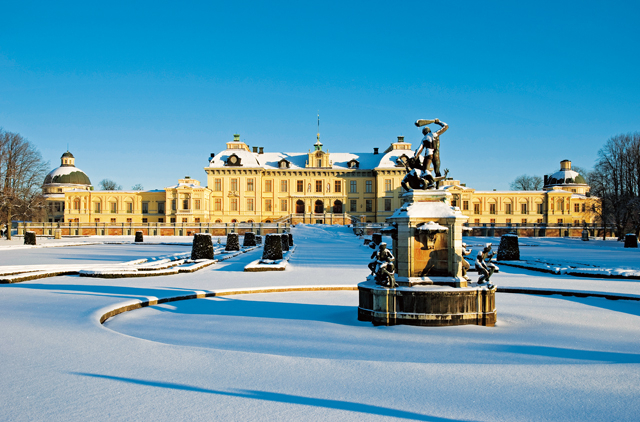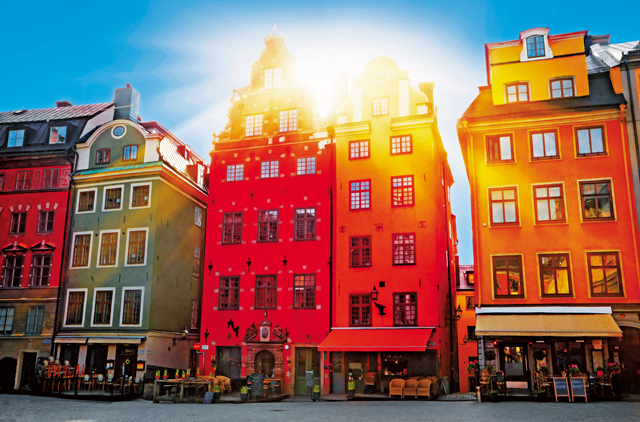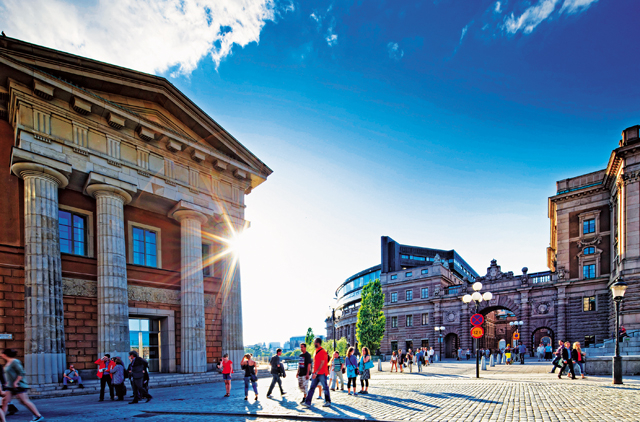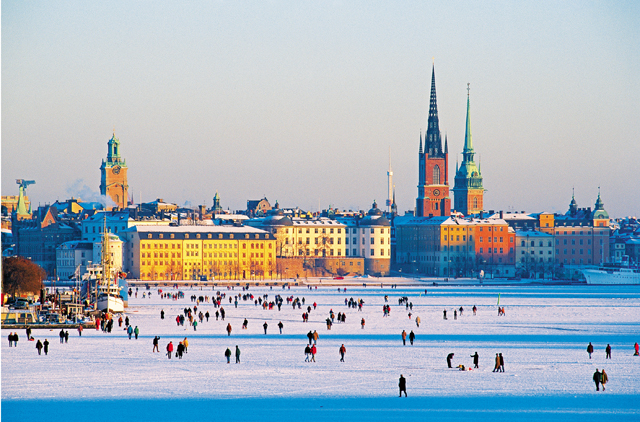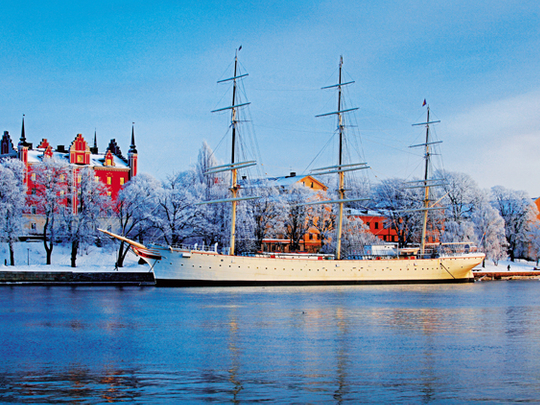
I was standing in the centre of the Swedish capital, Stockholm, knee-deep in snow, when I chanced upon the beautiful Kungsträdgården Park, a hive of activity near the city centre. The park had in it an ice rink dating back to 1962, which had been modelled on the one near New York’s Rockefeller Centre. Youngsters were having ice skates strapped on to tiny feet while accomplished skaters were whizzing round at speed. On the sidelines, vendors sold hot soup, music played and everyone seemed to smile. And then, as if the heavens had opened and a choir of angels was launching into full voice, the joyous sound of Abba’s Dancing Queen filled the air. “You can dance, you can jive...”.
You couldn’t make it up. Popular cliché relegates Sweden to the land of Volvo, Abba, Ikea and elongated vowels. But it is so, so much more. One of Europe’s most beautiful, peaceful and enthralling nations, it’s a mystery why it features so infrequently on the itineraries of travellers. Sweden boasts a high standard of living and has some of the finest restaurants and retail in northern Europe. Much as I was thrilled to hear Anni-Frid, BjÖrn, Benny and Agnetha sing while watching Stockholmers ice skate at Kungsträdgården, the Dancing Queen interlude was not the most enjoyable moment of a blissfully enjoyable weekend. That came as I wandered the streets of Gamla Stan, one of Europe’s best-preserved medieval centres. Dating back to the 13th century, Gamla is a maze of iconic buildings that surround its square, Stortorget. There are ethereal churches, narrow alleys and thoroughfares.
Impressive as they are, the most incredible quality was the light. I visited shortly before winter turned to spring, when the sun was slow to rise and quick to set. In the morning, brilliant silvery shapes danced across the ripples of the Stockholm archipelago, casting silhouettes of sailing ships in the coolness. During the day, the blood red and bold orange buildings of Gamla Stan seemed to glow as a warm, cheerful bloom of midday flushed the radiant city. And as evening came, intense crimson, rose and gold colours combined to leave a vivid incandescence. Not that there was an abundance of time to ponder the shimmering light of Stockholm.
The city was a treasure trove of delights, with museums, galleries, exhibitions and myriad other attractions. For this enthusiastic foodie, first among those was F12, one of Stockholm’s Michelin-starred restaurants. Located at the commanding Royal Art Academy premises, F12 showcased the impeccable culinary talent of head chef Danyel Couet. Scandanavian cuisine is among the most exciting on the planet and Couet’s 11-course tasting menu scaled new heights of adventure and sophistication. Cod from Lofoten with roe, Cecile potatoes and truffles was majestic; milk-fed lamb with soured grapes, turnips and green mustard was stunning; while raw shrimps with horseradish created a carnival for the senses. His signature dessert, chocolate with sweetcorn ice cream, burnt milk foam and fennel, was extraordinary. The service was exquisite.
I took time to enjoy the incredible waterfront views from the room of my hotel, First Hotel Reisen. Overlooking Strommen, it was an enchanting building with roots in the 18th century and it offered handsome furnishings and a winning blend of trend and tradition. I spent a long, lazy and relaxing afternoon enjoying the elegantly furnished room, my nose buried deep in a book, as the shadows danced through the windows.
Shopping and culture
Stockholm is a city of shoppers and I took myself to NK – Nordiska Kompaniet – the city’s leading department store, to browse fashion, food and fitments. I had neither the money, nor space in my luggage for some of the items that were on sale – but elected to indulge in some window shopping anyway. Beyond the shops and incredible architecture were museums, galleries and other buildings that are steeped in history and tradition. And, because Stockholm is so compact and easily navigable, it’s not difficult to visit many in a day.
The National Museum was a smorgasbord of artistic delights, from contemporary design collections to works by Sweden’s foremost painters as well as Rembrandt, Rubens, Goya, Gauguin, Degas and Renoir. The Lutheran Storkyrkan Cathedral was spellbinding, offering unique insight into worship down the ages – not to mention a peek at the venue selected for the wedding last year of Crown Princess Victoria and Prince Daniel Westling. Stockholm’s most distinctive building, Kungliga Slottet (The Royal Palace) is a thrilling amalgam of marble, wood, silk – and parading guards, who call to mind a more chivalrous era. The Palace itself is all straight lines and imposing architecture and it dominates the centre of the city.
Although it is still home to King Carl XVI Gustaf, and other members of the Royal Family, it is open to the public. I was able to wander through the corridors to see some of the rooms that are used when visiting heads of state fly into Sweden. The palace was built during the 13th century, although much of the work on the present building dates back to the late 17th and early 18th centuries, and is vast, with 1,430 rooms, 660 of which have windows. Another Stockholm building that is just as magical is the Nobel Museum, an inspiring illustration of a century of peacemaking and creativity.
Books, experiments and treaties that changed the world have been honoured in the Scandanavian seat of laureates. The museum honours the achievement of Nobel Prize founder Alfred Nobel and is located, along with the Nobel Library and Swedish Academy, in the former BÖrshuset (Stock Exchange Building), deep in the heart of Gamla Stan. Exhibitions, films and other displays relating to science, the arts, history and more besides tell the incredible story of such characters as Marie Curie, Nelson Mandela, Martin Luther King, Selma Lagerlof, Wilhelm Conrad and writers like Ernest Hemingway and Samuel Beckett.
Expanding horizons
There is much more to Sweden than its beautiful capital city and I found time to move up-country. Sweden has a population of under ten million, but is roughly the size of California or Spain – or more than five times the size of the UAE. There are three key regions; the GÖtaland which fills the southern part of the country, Svealand which comprises the central portion and the sparsely populated Norrland, the northern part. Norrland has a reputation for great hiking, big rivers, enormous marshes and high mountains that dot the Swedish border with Norway. GÖtaland, in contrast, has numerous islands and provinces, as well as a number of well-known cities like Malmo and Gothenburg.
I managed to visit Svealand, which is closest to Stockholm. It was a beautiful part of the country with an incredible landscape and great history. The university city of Uppsala and the administrative centre of Falun were both interesting stop-overs, but the province of Dalarna was my favourite. It comprised numerous small towns and had some of the most breathtaking scenery imaginable.
A reason to return
Sweden was a fascinating destination with great food, shopping and scenery, not to mention incredible heritage and history. There was an additional quality to Sweden that was remarkably enjoyable – the people. Courteous, polite and charming; they made my trip utterly memorable. In Gamla Stan, as I bumbled from pillar to post, locals offered helpful directions and advice. In Svealand, where local knowledge was essential, they offered insider information about great places to view or photograph. And when I sought restaurant recommendations and details on markets and views, locals were always willing to offer help.
My journey past in a flash and the passport-control officers at Stockholm Airport were typically helpful. “Did you enjoy your visit to Sweden, sir?” they asked, as I presented my boarding papers. “Of course,” I answered. The border patrol continued: “And do you think you will come back and visit Sweden again?” I was tempted to answer in the words of that classic Abba hit: “I Do, I Do, I Do, I Do, I Do”.


